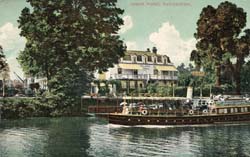Eel Pie Island
Former home to a bowling alley
1635

The island was previously known as Twickenham Ait, and before this, in the Churchwardens' Accounts for 1608, the Parish Ayte, reflecting the ownership. In earlier times it was actually in three parts and Jean Rocque's map of 1741 shows two parts.
It has been claimed that the island was once connected to the Twickenham bank by a pre-historic causeway. Mesolithic/Neolithic artefacts: flints, horn implements, axes and hammers have been found in the river bed and on the island.
It seems to have been a place for recreation as early as the beginning of the 17th century. Moses Glover's map of 1635 notes a plot of land as "hath bin A Boulding Alley". Only accessible by boat it still supported a public house first named The Ship, later The White Cross, during the 18th century. Henry Horne (1724-1814) is noted as the licensee of the White Cross in the Ayte for a number of recorded years between 1780 and 1795. In 1781 Mary Horne was the named licensee and in 1801 Elizabeth Horne owned the licence in company with William Fielder. The earliest mention of a public house of this name is in 1775 although there was, in 1737 one called Ship in the Ayte. No doubt this hostelry catered for passing river trade as much as the local population.

Samuel Lewis's map of 1784 shows the inn in the centre of the Ait inscribed "Mr Horn". Henry Horne was also a waterman: in 1788 he took the lease of the Twickenham Ferry from Lord Dysart, renewing this until 1803, for the last time.
The White Cross was replaced with a much larger establishment in 1830 and the island became a popular resort for visitors and boating parties, some brought by steamer. A watercolour by Thomas Rowlandson gives a flavour of leisure: various boats coming and going and visitors enjoying alfresco refreshment beneath the trees. The eel pies served were famous and led to the renaming of the island although with increased pollution the eel population declined and pies are no longer made.

The larger establishment took the name Eel Pie Hotel and the contribution which this establishment made to the development of British Pop music is described in another piece. It closed and was burnt down in 1971 while being demolished.

Twickenham Rowing Club was founded in 1860 under the presidency of the Duc d'Aumale (1822-1897) then living at Orleans House and in 1880 built its headquarters on the island. Like Twickenham Ferry and, later, Hammerton's Ferry it acquired a celebratory piece of music. Composed by W Vincent Wallace, The Oarsman's March was scored for solo piano and dedicated to the Twickenham Rowing Club. Published by Robert Cocks & Co it was apparently published while 'his Imperial Majesty the Emperor Napoleon III' was still on the throne.
In 1889 there was a proposal to establish an open air swimming pool at the upstream (southern) end of the island together with a bridge for access. Only the bridge was ever built, and that not until 1957.
Today, the island is now largely residential but sustains a boat-building and craft workshop community. It also boasts a small bird sanctuary at its southern end. It remains connected to the mainland by a new bridge, though comfortably detached from the hurly-burly of Twickenham, for its residents.




